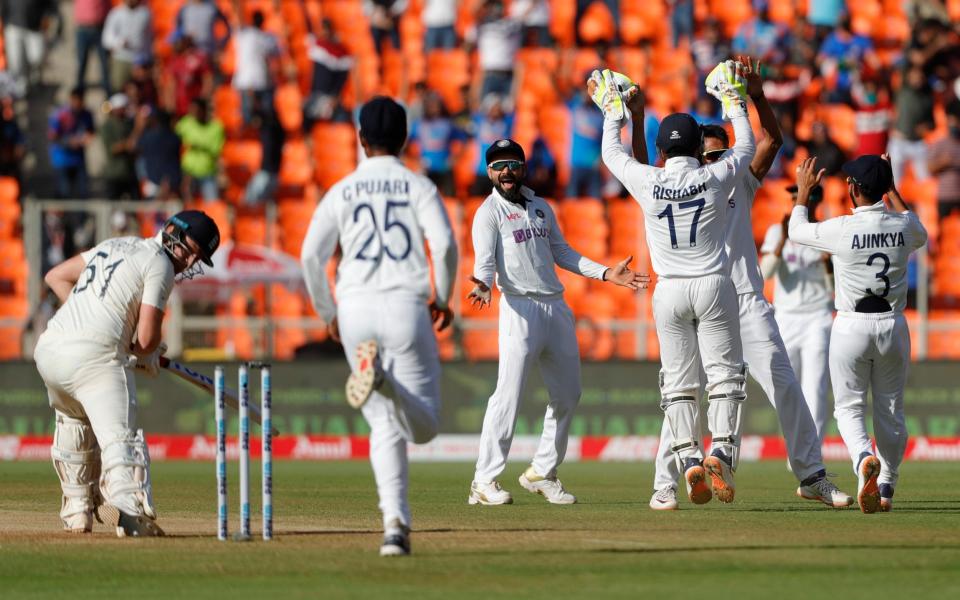Dismissed for a pair on his return, Jonny Bairstow's plight shows how isolating and cruel Test cricket is

Jonny Bairstow is the first England player – not just batsman but any player – to make a pair under lockdown. It could not have happened to someone more likely to fume and fret in the week before the fourth Test.
Bairstow was “in a good place”, as psychologists now say, during England’s two-Test series in Sri Lanka. He was not the wicketkeeper, as he would still like to be, but at number three he was the senior batsman after Joe Root and vice-captain Ben Stokes. He buzzed around the in-field as a close-catcher. He felt at home in that he had made a century in his previous Test in Sri Lanka. Bairstow felt secure, above all, and wanted.
Whereupon he was sent home. England’s selectors decided Bairstow should miss the first two Tests in India. They had good reason. When Bairstow re-joined the touring team in Chennai, he spoke to Channel 4 viewers about how he had needed a break and time with his family – that vital support network including his mother and sister who have helped him cope since his father’s death.
Bairstow had played in the autumn edition of the Indian Premier League in the UAE, followed by England’s white-ball series in South Africa. Three weeks at home over Christmas then off to Sri Lanka on January 2. He is an integral part of England’s 20-over and 50-over teams, which will be playing India until the end of March, then he has exercised his right to play in the spring IPL, so when else could he escape from his hotel room?
Once he returned to India though, Bairstow’s four useful innings in Sri Lanka were the distant past. In the third Test at Ahmedabad he had no time to play himself in again before India’s spinners came on. He was dismissed by his first ball of spin in his first innings and by his second ball in his second, only surviving the first by calling for a DRS review. His desperation to avoid a pair was evident both in his choice of shot – a sweep at his first ball from Axar Patel – and in calling for a review of the LBW verdict without pausing to consult his partner.

Had he stayed in India for the Chennai Tests, and helped himself on the placid surface where Root made his double-hundred, Bairstow could have hacked a 30 or 40 on day one in Ahmedabad that would have given England a working total of 200. Had Moeen Ali not been rested, he could have slapped a couple of 20s which, along with his bowling instead of a third seamer, might again have made the difference between England going 2-1 up in a thriller and going down to an overwhelming defeat.
Other England batsmen are in a similar plight. Ollie Pope’s run-tallies this winter have steadily descended: 34, 28, 22, 12, 1 and 12. Once the next Ian Bell, or a combination of Root and Bell, he has become a puppet on Ravichandran Ashwin’s string.
Dan Lawrence too, in his four Tests, faded after a bright start in Galle. Rory Burns was dropped after only four innings. It is as well that the England team’s hotel in Ahmedabad is not part of the stadium. Staring for a week at the place where you have been dismissed for 112 and 81 would do anyone’s head in.
Bairstow, however, is unique among these England players. He is 31 and his chances to become England’s regular Test number three are running out, so he heaps all the more pressure on himself. Nobody would have thought it on England’s last Test tour of India in 2016, when he was the first name on the team-sheet as keeper/batsman, but this is how his wheel has turned.
He is unique too within this England team for the desperately tragic circumstances of his childhood, and publicly recounting them in a book has not made them easier. As the last World Cup was handed to Eoin Morgan at Lord’s, Jos Buttler kindly said to Bairstow that his father would be proud; and, so raw is the wound, that Buttler admitted in an interview on Sky he should not have mentioned it at all.
Test cricket at its peak, like a series in India, has always been a test of every fibre of a cricketer’s being, but never more so than now. Never has a batsman been left alone for so long to contemplate so much, in what has traditionally been the most sociable of activities.
Post-Covid historians may conclude that England cricketers who tried to be multi-format players during the pandemic were doomed to failure: that achieving in every format all the time is currently impossible. Bairstow however is intense enough to try, for himself and maybe someone else.
If cricket can be cruel though – crueller than any other sport because a Test series abroad goes on for so long away from home – and particularly in the last year of bio-bubbles, it still offers the simplest solutions. Watch the ball, look for the single, and think of nothing else.

 Yahoo Sport
Yahoo Sport 





































